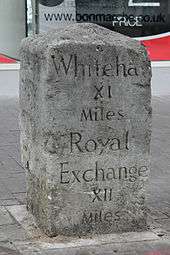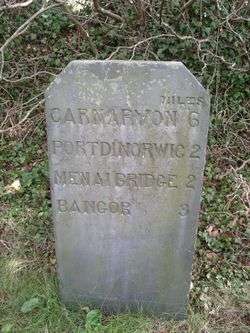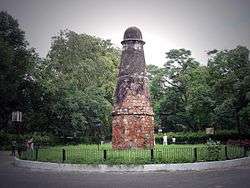Milestone

A milestone is one of a series of numbered markers placed along a road or boundary at intervals of one mile or occasionally, parts of a mile. They are typically located at the side of the road or in a median. They are alternatively known as mile markers, mileposts or mile posts (sometimes abbreviated MPs). Mileage is the distance along the road from a fixed commencement point.
Colloquially, the term "milestone" may also refer to markers placed at other distances, such as every kilometre.
Milestones are constructed to provide reference points along the road. This can be used to reassure travellers that the proper path is being followed, and to indicate either distance travelled or the remaining distance to a destination. Such references are also used by maintenance engineers and emergency services to direct them to specific points where their presence is required. This term is sometimes used to denote a location on a road even if no physical sign is present. This is useful for accident reporting and other record keeping (e.g., "an accident occurred at the 13 mile mark" even if the road is only marked with a stone once every 10 miles).
History
Roman Empire

Milestones (Latin: Milliarium) were originally stone obelisks – made from granite, marble, or whatever local stone was available – and later concrete posts. They were widely used by Roman Empire road builders and were an important part of any Roman road network: the distance travelled per day was only a few miles in some cases. Many Roman milestones only record the name of the reigning emperor without giving any placenames or distances.[1] The first Roman milestones appeared on the Appian way. At the centre of Rome, the "Golden Milestone" was erected to mark the presumed centre of the empire: this milestone has since been lost. The Golden Milestone inspired the Zero Milestone in Washington, D.C., intended as the point from which all road distances in the United States should be reckoned. Odometers were used to measure the Roman milestone spacing, most likely based on Ancient Greek Technology.
Byzantine Empire
A mile-marker monument, the Milion, was erected in the early 4th century AD in Constantinople. It served as the starting point for measurement of distances for all the roads leading to the cities of the Byzantine Empire, and had the same function as the Milliarium Aureum of Ancient Rome. The Milion survived intact until at least the late 15th century. Its fragments were discovered again in the late 1960s. A fragment is re-erected as a pillar.
Post-Medieval Europe
In Europe, the distance measured typically starts at specified point within a city or town, as many roads were named for the towns at either end. For example, in London, United Kingdom, a plaque near the Eleanor cross at Charing Cross is the reference point from which distances from London to other towns and cities are measured. In the UK, milestones are especially associated with former Turnpike roads.
The British built many milestones on the island of Malta. They consisted of large slabs of local hard rock and they were engraved with the distance to or from a particular location. Many of these were defaced in World War II to disorientate forces in a potential invasion. Despite this, a very small number of milestones still exist undefaced, and one of these is now in the Malta at War Museum.[2]
India
The Kos Minars or Mile Pillars are medieval milestones that were made by the 16th-century Afghan Ruler Sher Shah Suri and later on by Mughal emperors. These Minars were erected by the Mughal Emperors on the main highways across the empire to mark the distance. The Kos Minar is a solid round pillar, around 30 feet (9.1 m) in height that stands on a masonry platform built with bricks and plastered over with lime. Though not architecturally very impressive, being milestones, they were an important part of communication and travel in a large empire.[3]
Kos is an ancient Indian unit of distance. It can represent either a distance of approximately 1.8 kilometres (1.1 mi) or 3.2 kilometres (2.0 mi). Minar is a Persian word for tower. Abul Fazl recorded in Akbar Nama that in the year 1575 AD, Akbar issued an order that at every Kos on the way from Agra to Ajmer, a pillar or a minar should be erected for the comfort of the travelers.[4][5]
Modern highways
The historical term milestone is still used today, even though the "stones" are typically metal highway location markers and in most countries are based on metric rather than imperial units of measure. Also found today are more closely spaced signs containing fractional numbers, and signs along railways, beaches and canals.
Australia
Metrication in Australia caused the former mile markers to be gradually replaced with 10 km markers on highways and country roads, and even these have been removed from most major highways with distances to several towns ahead being shown on signboards. Some mile markers are retained as curiosities (see gallery).
Canada
Usage varies by province, as highways are under provincial jurisdiction. In Alberta, for example, kilometre markers are green metal signs with white lettering, and are generally placed every 4 km starting at the last major intersection to the south or west, depending on whether the route runs north-south or east-west.
India

Milestones on Indian highways typically have white backgrounds with yellow tops (on national highways) or green tops (on state highways). The names of cities and distances are painted in black. The names of the nearest towns and cities are written along with distance in kilometres. On undivided highways, both sides of the milestones are used, telling the distance to the nearest cities in each direction. The highway number is written on the head of the milestone. The sum of the distances of two nearest cities in each direction from the milestone is listed on the side.
United Kingdom
In the UK, driver location signs are placed every 100 metres (110 yd) along each side of British motorways, and along some other major roads. They were first introduced in 2003, and they complement distance marker posts (small roadside posts used for road maintenance and administrative purposes). Both types of sign display a unique location number. The number, although given without units, is the distance in kilometres from a designated datum location for the road.[6]
United States

In the U.S. Interstate Highway System, the numbers usually measure the distance to the southern or western state line, or the route's terminus, if the national southern or western terminus lies in that state. The numbering system for other highways varies by state; most use a system mirroring that of the Interstate System, other states, such as Illinois and Kentucky, use the county line as the zero mile marker, while others, including Missouri, do not sign mile-markers at all (except on Interstates). Arizona has a rather unique system, where a route's mileposts continue those from its original host. Often, the exits are numbered according to the nearest milepost, known as the mile-log system. From the beginning of the Interstate system until the mid-2000s, most Interstate highways had markers every mile. Since that time, many states have installed markers every 0.2 mile, and in some metro areas, every 0.1 mile. Some historic and scenic routes – such as along the Blue Ridge Parkway in North Carolina and Virginia and the Overseas Highway of the Florida Keys – use mileposts to mark points of interest or (in the cases of many businesses along the Overseas Highway) as a portion of their address.
Myanmar

In Myanmar, furlongs are currently used in conjunction with miles to indicate distances on highway signs. Mileposts on the Yangon-Mandalay Expressway use miles and furlongs.
Zimbabwe
Zimbabwean milestones are constructed of cast concrete painted white with the kilometre distance indented and painted black.[7] There is no distinction between state and national road-sign markings. They were originally sited every 500 metres by the Rhodesian Ministry of Roads and Road Traffic, starting at zero from the largest town or city. In 1980 the Zimbabwean government began placing new markers 1 km apart and damaged or missing half kilometre markers were no longer replaced.
Railway mileposts

The Railways Clauses Consolidation Act 1845[8] compels UK railway companies to provide their passengers with a means of determining the distance travelled (fares were set by distance at this time). Section 94 states:
"The company shall cause the length of the railway to be measured, and milestones, posts, or other conspicuous objects to be set up and maintained along the whole line thereof, at the distance of one quarter of a mile from each other, with numbers or marks inscribed thereon denoting such distances."[9]
Similar laws were passed in other countries. On the modern railway, these historical markers are still used as infrastructure reference points. At many points, the distances shown on the markers are based upon points no longer on the network – for example, distances measured via a closed line or from a junction which has subsequently been moved. Whole mileposts are usually supplemented by half and quarter posts. Structure signs often include the mileage to a fair degree of precision; in the UK, a chain is the usual accuracy. In the U.S. and Canada, miles are "decimalized", so that, for example, there may be a "milepost 4.83" to mark a junction, crossing, bridge or tunnel.
In metricated areas, the equivalent is the "point kilométrique".
Boundaries
Surveyors place milestones to mark the boundaries between the jurisdictions separated by borders. A series of such boundary markers exists at one mile (1.6 km) intervals along the borders of the District of Columbia in the United States.
Gallery
- United Kingdom


- Milestone on the A5130 in Broughton, Milton Keynes
 Milestone on the B3318 in Penwith, Cornwall
Milestone on the B3318 in Penwith, Cornwall
- Milestone on B5500, in the township of Balterley, Staffordshire
- Milestone on the B940 near Lathones in Fife, Scotland
 Milestone on Sutton High Street, Sutton, London
Milestone on Sutton High Street, Sutton, London
- Australia
- Milepost 18 from Batemans Bay, New South Wales, now preserved in the town. 35°42′05″S 150°10′53″E / 35.7014°S 150.1815°E
- Denmark
- India
 A milestone near Haridwar on an Indian highway
A milestone near Haridwar on an Indian highway
- United States
- 1774 Caleb Aldrich milestone on Great Road in Rhode Island, United States
 Milestone 8 on the Upper Boston Post Road in Harvard Square, Massachusetts, United States
Milestone 8 on the Upper Boston Post Road in Harvard Square, Massachusetts, United States Milestone along the boundary of the original District of Columbia set in 1792 and now marking the boundary between Washington, D.C., and Maryland in the United States.
Milestone along the boundary of the original District of Columbia set in 1792 and now marking the boundary between Washington, D.C., and Maryland in the United States.
See also
- Boundary marker
- Highway location marker
- Kilometre zero
- Milepost equation
- Parting stone
- Reassurance marker – a road sign with a route number, but no distance
- Survey marker
- Waymarking
References
- ↑ Collingwood, R. G.; Wright, R. P. (1965). The Roman Inscriptions of Britain. I: Inscriptions on stone. Oxford: Clarendon Press.
- ↑ "Milestones salvaged and added to the new museum's collection". Wirt Artna. Archived from the original on 7 September 2014. Retrieved 7 September 2014.
- ↑ "'Monumental' treasure house". The Times of India. Jul 12, 2009. Retrieved 2013-09-23.
- ↑ Kos Minar University of Alberta.
- ↑ Khandekar, Nivedita (October 27, 2012). "A milestone on the highway". Hindustan Times. Retrieved 2013-09-23.
- ↑ Highways Agency. "Driver Location Signs - Frequently Asked Questions". Archived from the original on 2012-08-10. Retrieved 2010-02-10.
- ↑ "Poultney Family - Mort's Tree". 5 September 2009. Retrieved 13 April 2012.
The kilometre marker near the tree - distance from Bulawayo [Photo caption]
- ↑ "94 Milestones". Railways Clauses Consolidation Act 1845. Retrieved 2008-11-03.
- ↑ "Section 26: Distance Markers". Railway Signs and Signals of Great Britain. Retrieved 2007-04-08.
External links
| Wikimedia Commons has media related to Milestones. |
- "Brief History of American Milestone Markers". Stones of Northeastern United States. Retrieved 24 August 2014.
- Milestone in Ayrshire, Scotland
- The Milestone Society UK
- Mileposts and milestones on the Leeds Liverpool Canal
- Article in Smith's Dictionary of Greek and Roman Antiquities with further links, including to a photograph of a Roman milestone in Orvieto
- Inventory of Roman milestones in France (in French)
- Section 2D.46 of the U.S. Manual on Uniform Traffic Control Devices
- MileStonesGurus, a weblog pictures project with only milestones with an equal KM point



